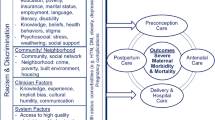Abstract
A study was made of health service utilization patterns during pregnancy of 279 young mothers, a representative sample of the Jewish population in Jerusalem. Only 47% reported that they used the municipal family health centers (FHCs) for prenatal care. Some 82% reported that they had resorted to more than one source of care during pregnancy. Sources other than the FHC were: regular Sick Fund doctor service (33%); private practitioners (25%); hospital-based services (25%). Among the FHC users, there was an unexpectedly high percentage of women of Asian-African origin and of those living in remote neighborhoods. Under-utilization was frequent among wealthy women, those with higher education and members of the Orthodox religious sector. While there was general satisfaction with the service, lower gratification was associated with higher utilization. This phenomenon may intimate that there may be a process of negative selection among women who use the service, when other alternatives are not readily available.
Similar content being viewed by others
References
AndersenR. and NewmanJ. (1973): Societal and individual determinants of health care utilization in the U.S. Mil. Mem. Fund Quart. 51:1, 95–124.
BerkiS.E. and AshcraftM.L. (1979): On the analysis of ambulatory utilization. An investigation of the roles of need, access and price as predictors of illness and preventive visits. -Med. Care 12: 1163–81.
BiceT.W., RabinD.L., StartleldB.H. and WhiteK.L. (1973): Economic class and use of physician service. -Med. Care 6: 287–296.
EllencweigA.Y. (1987): Student'sappraisal of community services — some useful implications. - J. Management Med. 2: 27–37.
FreebornD.K., PopeC.R., DavisM.A. and MulloolyJ.P. (1977): Health status, socio-economic status, and utilization of outpatient services for members of prepaid group practice. - Med. Care 15: 115–128.
HersheyJ.C., LuftH.S. and GianarisJ.M. (1975): Making sense out of utilization data. - Med. Care 12: 838–854.
HulkaB.S. and WheatJ.R. (1985): Patterns of utilization, the patient perspective. - Med. Care 23: 438–460.
KarkS.L. (1981): The practice of community oriented primary health care. New York: Appleton Century Crofts.
LeopoldE.A. (1974): Whom do we reach? A study of health utilization. Pediatrics, 53: 341–51.
MedalieJ.H. (1962): Patient waiting time as an index of medical care. - Israel Med. J. 21: 252–9.
Salkever D.S. (1976): Accessibility and the demand for preventive care. - Soc. Sci. Med. 10: 469–475.
Statistics Abstract of Israel - 1984 (1984): Jerusalem: Central Bureau of Statistics, No. 35.
Use of health services survey -1981 (1983): Jerusalem: Central Bureau of Statistics. - Special series No. 717.
WolinskyF.D. (1978): Assessing the effects of predisposing, enabling, and illness-morbidity characteristics on health service utilization. - J. Health Soc. Behavior 19: 384–396.
YuE.S.H. and CyressB.K. (1982): Visits to physicians by Asian/Pacific Americans. - Med. Care 20: 809–820.
Author information
Authors and Affiliations
Rights and permissions
About this article
Cite this article
Ellencweig, A.Y., Ritter, M., Peleg-Olavsky, E. et al. Utilization of preventive services by pregnant women in Jerusalem — A cross sectional study. Eur J Epidemiol 6, 279–286 (1990). https://doi.org/10.1007/BF00150433
Issue Date:
DOI: https://doi.org/10.1007/BF00150433




